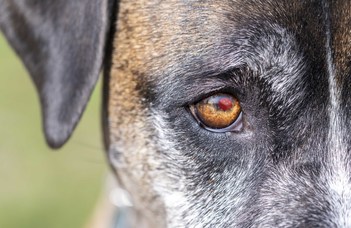Your Dog Understands that Some Words ‘Stand For’ Objects, New Study Shows

It’s no surprise that dogs can learn to understand and respond to human words. Your dog can learn to sit when you say “sit” and come when called. But a new study has made the surprising discovery by recording brain activity that dogs generally also know that certain words “stand for” certain objects. When they hear those words, they activate a matching mental representation in their minds. The findings are reported in Current Biology on March 22, 2024.
“Dogs do not only react with a learned behavior to certain words,” says Marianna Boros from the Neuroethology of Communication Lab of the Department of Ethology at the Eötvös Loránd University, Budapest, Hungary. “They also don’t just associate that word with an object based on temporal contiguity without really understanding the meaning of those words, but they activate a memory of an object when they hear its name.”
Word understanding tests with individuals who do not speak, such as infants and animals, usually require active choice, the researchers explained. They’re asked to show or get an object after hearing its name. Very few dogs do well on such tests in the lab, often fetching objects correctly at a rate expected by chance.
In the new study, the researchers wanted to look closer at dogs’ implicit understanding of object words by measuring brain activity using non-invasive EEG. The idea was that this might offer a more sensitive measure of their understanding of language.
They had 18 dog owners say words for toys their dogs knew and then present the objects to them. Sometimes they presented the matching toy while other times they would present an object that didn’t match. For example, an owner would say, “Zara, look, the ball,” and presented the object while the dog’s brain activity was captured on EEG.
The brain recording results showed a different pattern in the brain when the dogs were shown a matching object versus a mismatched one, similarly to what we see in humans, and what is widely accepted as evidence that they understand the words. The researchers also found a greater difference in those patterns for words that dogs knew better, offering further support for their understanding of object words. While the researchers thought this ability might depend on having a large vocabulary of object words, their findings showed that it doesn’t.

“Because typical dogs learn instruction words rather than object names, and there are only a handful of dogs with a large vocabulary of object words, we expected that dogs’ capacity for referential understanding of object words will be linked to the number of object words they know; but it wasn’t,” said Lilla Magyari, also of Eötvös Loránd University and University of Stavanger.
“It doesn’t matter how many object words a dog understands, known words activate mental representations anyway, suggesting that this ability is generally present in dogs and not just in some exceptional individuals who know the names of many objects,” Boros added.
The discovery that dogs as a species generally may have a capacity to understand words in a referential way, just as humans do, might reshape the way scientists think about the uniqueness of how humans use and understand language, the researchers say. That has important implications for theories and models of language evolution. For dog owners, it’s an important realization also.
“Your dog understands more than he or she shows signs of,” Magyari says. “Dogs are not merely learning a specific behavior to certain words, but they might actually understand the meaning of some individual words as humans do.
The researchers are now curious to know if this ability to understand referential language is specific to dogs or might be present in other mammals as well. Either way, they’re curious how this ability emerged and whether it depends on dogs’ unique experience of living with people. They also want to know why, if dogs understand object words, more of them don’t show it.
This study was published on the 22th of March in Current Biology titled “Neural evidence for referential understanding of object words in dogs”, written by Marianna Boros & Lilla Magyari, Boglárka Morvai, Raúl Hernández-Pérez, Shany Dror, Attila Andics. This research was funded by the Eötvös Loránd University, European Research Council (ERC) under the European Union’s Horizon 2020 research and innovation program (grant no. 950159), Hungarian Brain Research Program (HBRP) 3.0 NAP, Hungarian Academy of Sciences, a grant to the MTA-ELTE “Lendület” Neuroethology of Communication Research Group (LP2017-13/2017), Eötvös Loránd University, the Ministry for Innovation and Technology via the National Research, Development and Innovation Fund
Video abstract about the research:
On the Current Biology youtube channel: https://www.youtube.com/watch?v=5kL9VzMCfm8
On the Family Dog Project youtube channel: https://youtu.be/E9syiQu5U0U
Link to the article: https://www.cell.com/current-
X (formerly Twitter): https://twitter.com/famdogproject

